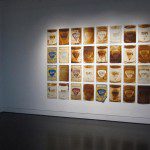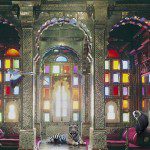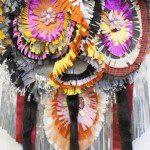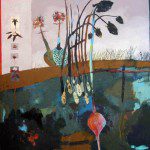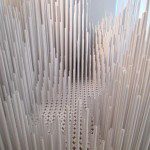14th Street Gallery Walk
By • August 15, 2013 0 1397

The first flecks of yellow are dotting the trees around Washington, a seasonal indicator that, among other things, signals the arrival of the fall arts season. The galleries around 14th Street, between U Street and Logan Circle, exhibit works by new and emerging local artists as well as those of national and international renown. The monumental quality of work brings together painting, sculpture, photography, installation and multimedia into a color show that rivals our annual foliage display. These galleries, all within a 15-minute walk of each other, represent the best of D.C.’s local art culture. Here’s what’s coming up.
Hamiltonian Gallery
“Heritage Aesthetic” is a new body of work by artist Amy Boone-McCreesh, which runs through Oct. 13, with an artist’s talk on Tuesday, Oct. 2 at 7 p.m. Exploring the dialogue between painting and sculpture, Boone-McCreesh sources a variety of materials, incorporating fabric, hand-made paper, rope and fur, to investigates the visual language of ceremonies and rites of passage while exploring themes of transformation and transcendence. Her found object installations are a pastiche of cultural heritage, adopting material cues from tribal ephemera, Middle Eastern ornamentation, and American Indian vestments. Her deconstructed global aesthetic appropriates the embellishment associated with celebrations from across the globe, speaking broadly to human accomplishment, customs and the universal tradition of decoration.
Gallery Plan B
Sheep Jones (on display through Oct. 14) is
a locally based artist, who operates a studio
out of the Torpedo Factory in Alexandria, Va. Working in oil and encaustic, her paintings, which look both timeless and fresh, transport us to a different place and state of mind—they are in themselves lessons in how to look at and interact with the world. Cavernous mysteries of color
and environment grow in the shadow cast by a worn, tin-roofed shack. A community of glowing, entwined root systems exposes the playful source of life beneath a garden. And though her work playfully celebrates of life, there is a graceful stillness that leaves you with a sense of calm, as if all is right and as it should be.
Hemphill Fine Arts
Hemphill opens its fall exhibition season with “William Christenberry:
Assembled Memory,” on view through Oct. 27. This retrospective of sorts
spans over 50 years and stretches seamlessly across Christenberry’s wide variety of media such as drawings, objects, photographs and sculpture. The work of this renowned artist is held in the
collections of the Hirshhorn, The Phillips Collection and MoMA, to name a few, and his exhibit at Hemphill brings together a diverse group of work from the earliest days of his career rooted in abstract expressionism, his mid-career, which speaks to the wonderment and pathos for the passage of time, and his more recent work, which expresses undercurrents of good and evil within our architectural heritage.
Adamson Gallery
Through Oct. 27, Adamson Gallery will host the work of London-based artist Karen Knorr. The
collaged images in her exhibit, “India Song,” insert animals into large format digital photographs of interiors in
various palaces, mausoleums and holy sites in India. The series takes inspiration from Indian mythology, depicting scenarios that are at once otherworldly and hyperreal, the lush and surreal images achieving feats of stunning, exotic beauty. In “Edge of the Forest, Agravena, Agra,” two tigers lie relaxed and aware at the entry to the Taj Mahal. Their presence defamiliarizes our knowledge of the Taj Mahal as a contemporary tourist attraction, moving the space out of the present and into a mythical past. The viewer becomes a traveler, not through space or time, but through worlds.
Project 4 Gallery
“TOIL” is an exhibition of recent work by British artist, Jill Townsley, in her first solo exhibition in the United States, at Project 4 Gallery through Oct. 13. Her work examines the role of repetition in life, through sculpture, installation, drawings and video. Through tedious, rote tasks like scribbling, counting
and stacking, and using materials as banal as cash register till rolls and hairgrips, Tillman transforms these objects into something greater. These gestures are the exploration of industrial, workmanlike environments—the way a factory operates or a clock’s gears turn. There is a piece of paper almost entirely black. Accompanying
it is a video that shows Townsley scribbling manically on a white sheet of paper, and we watch as the paper and her lines become lost in time.
- Sheep Jones “Peanuts” 48″ x 48″ oil on canvas | Gallery Plan B

